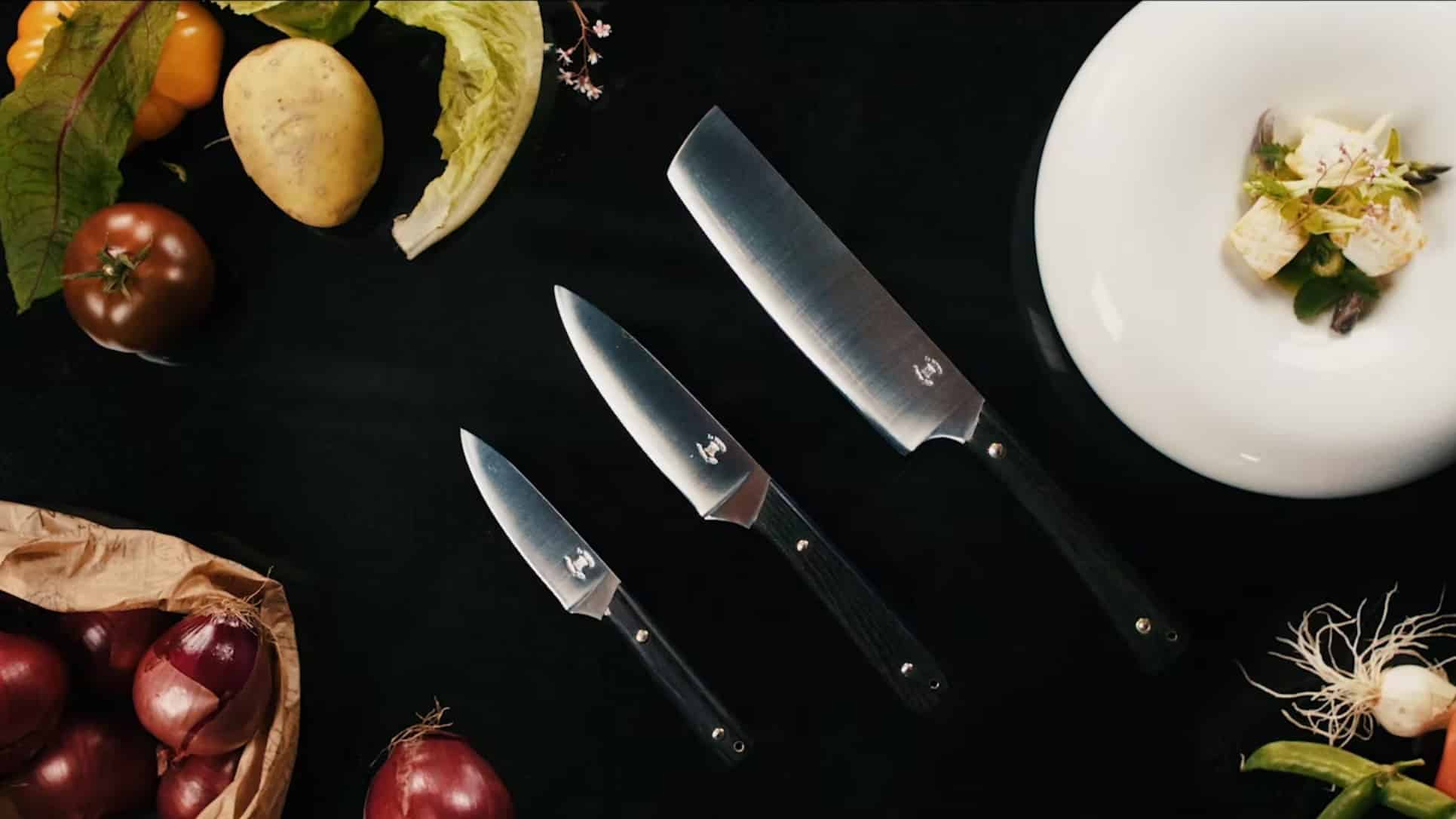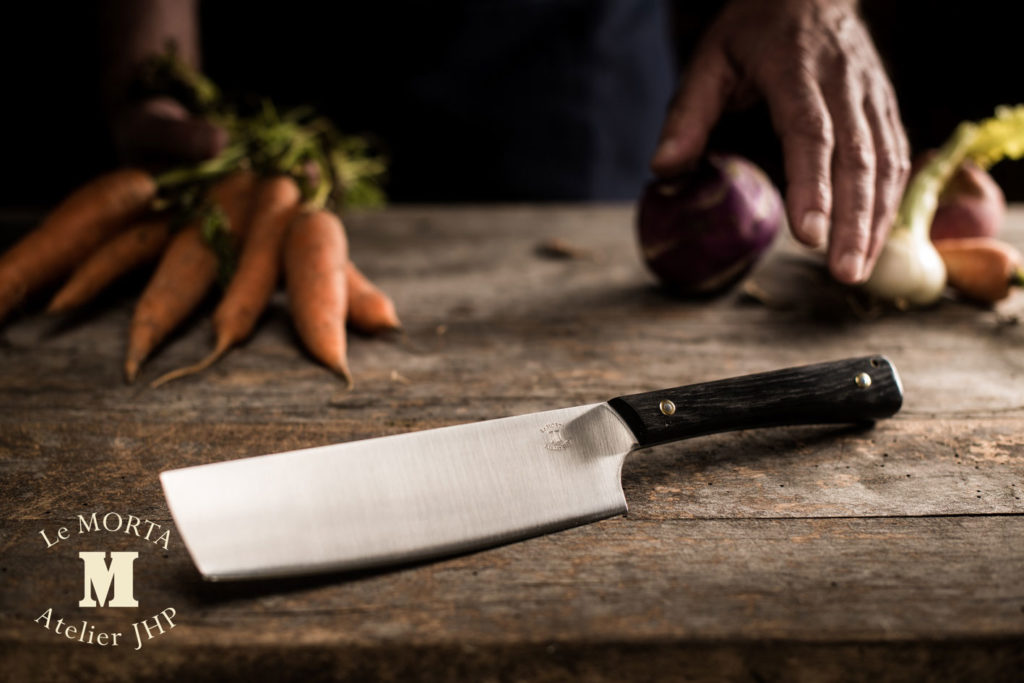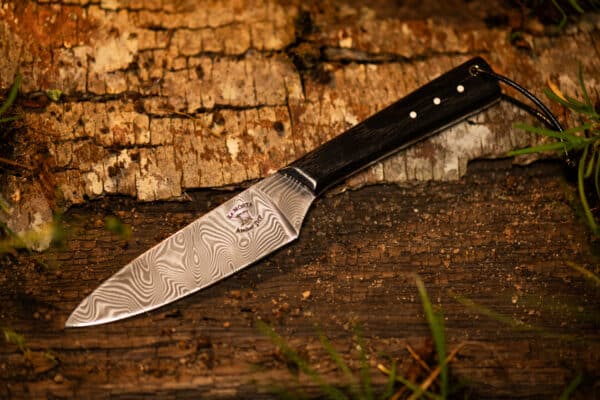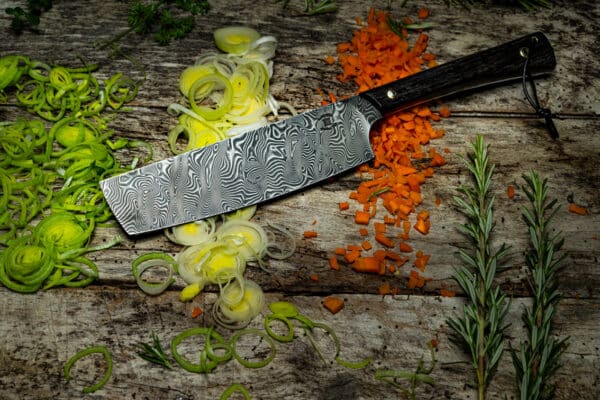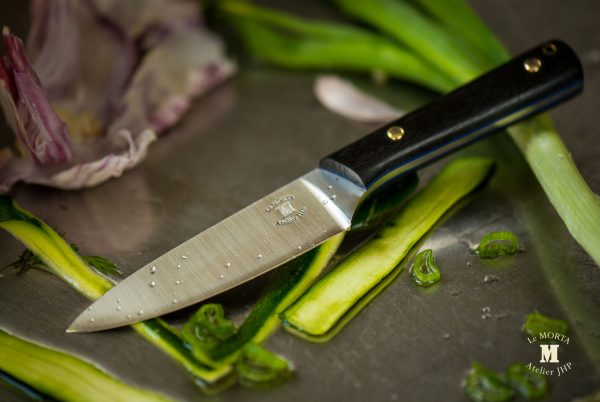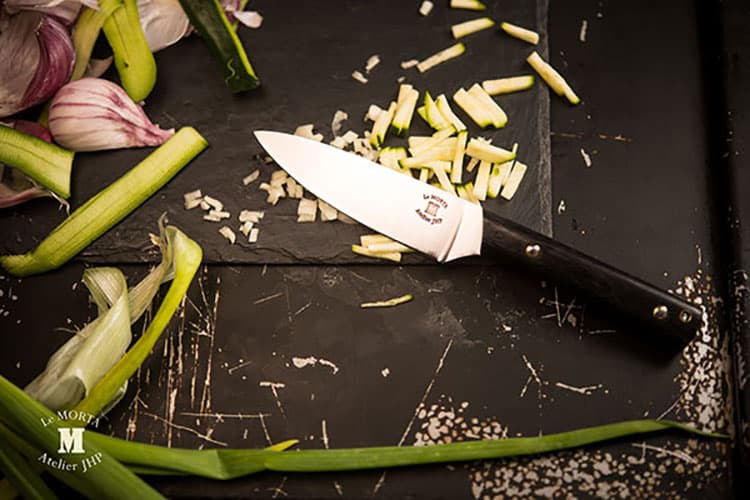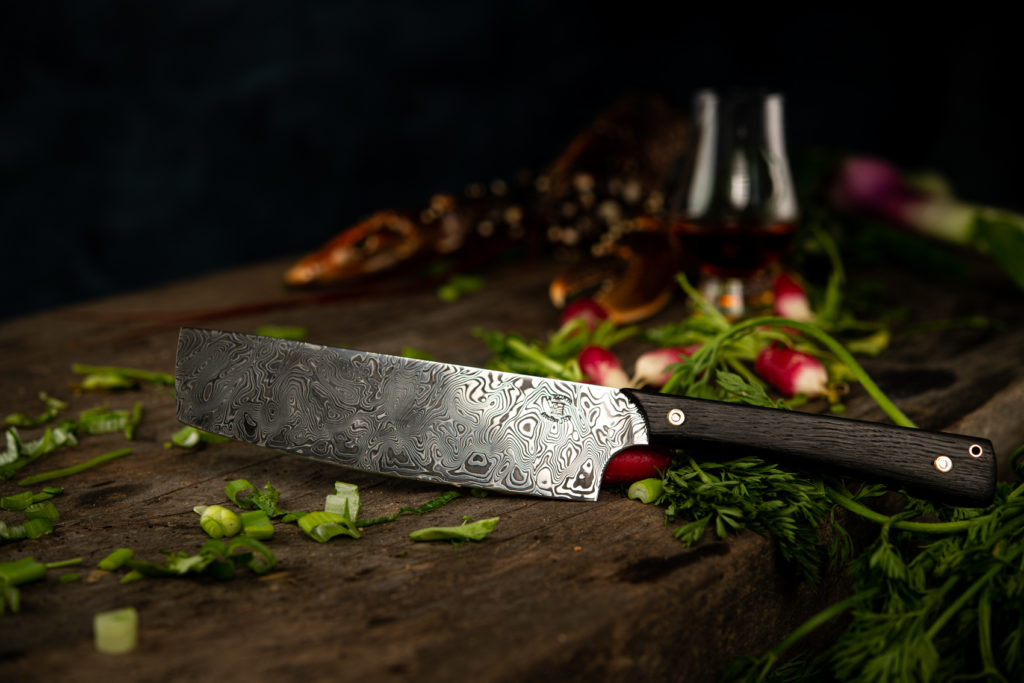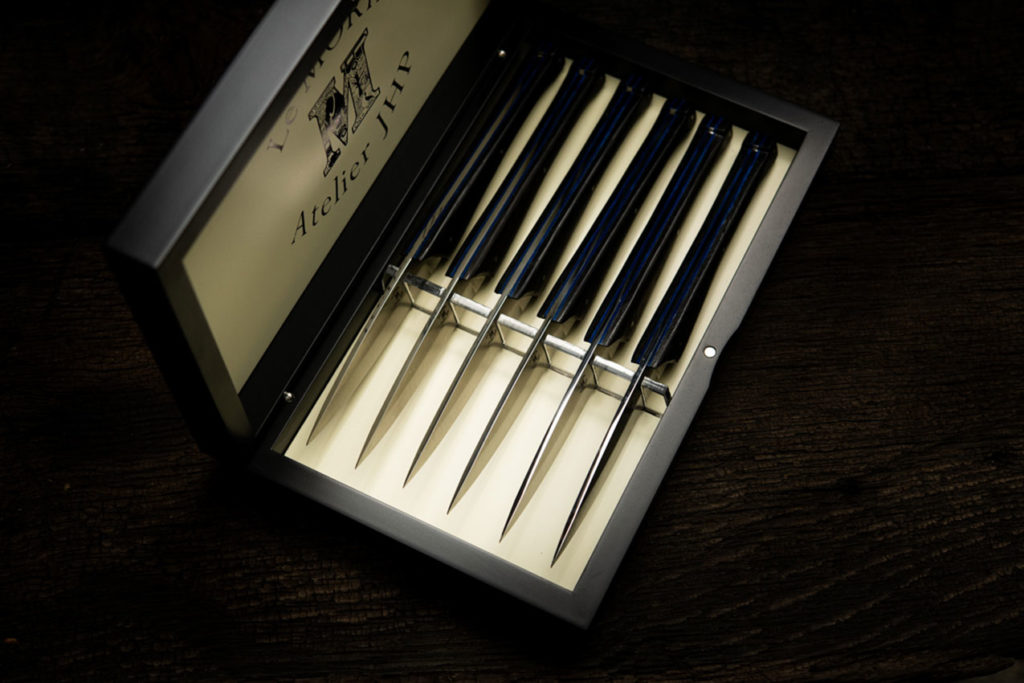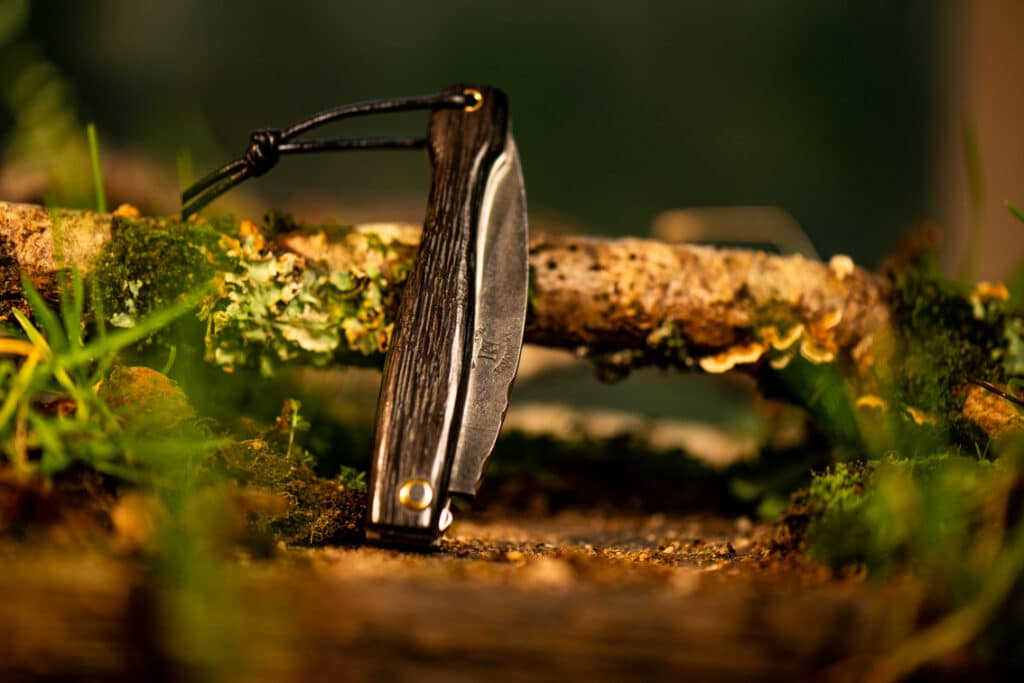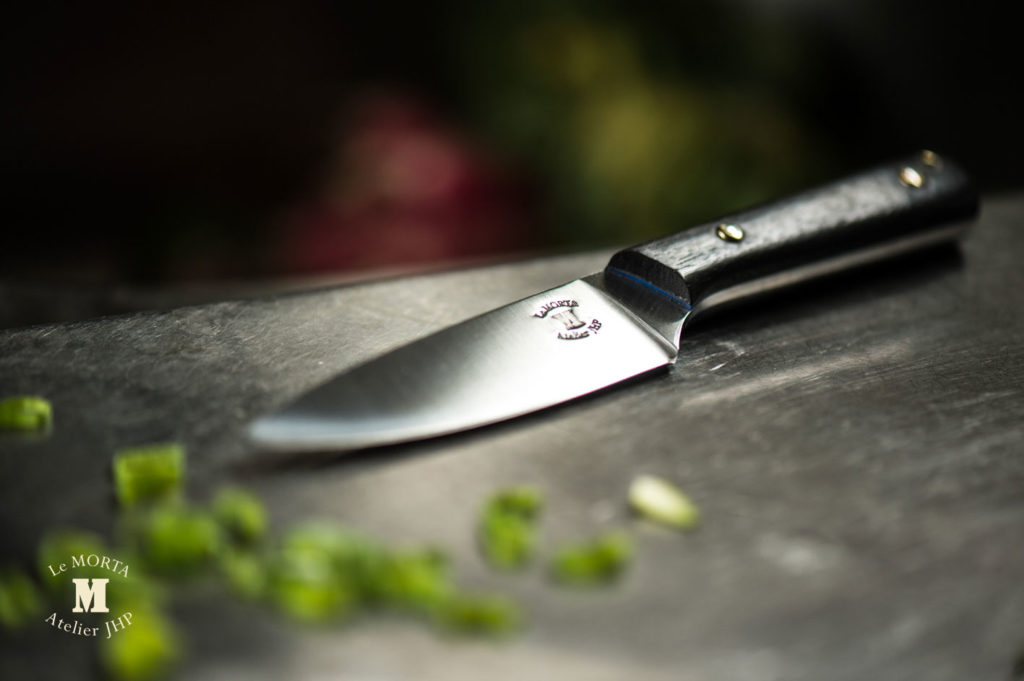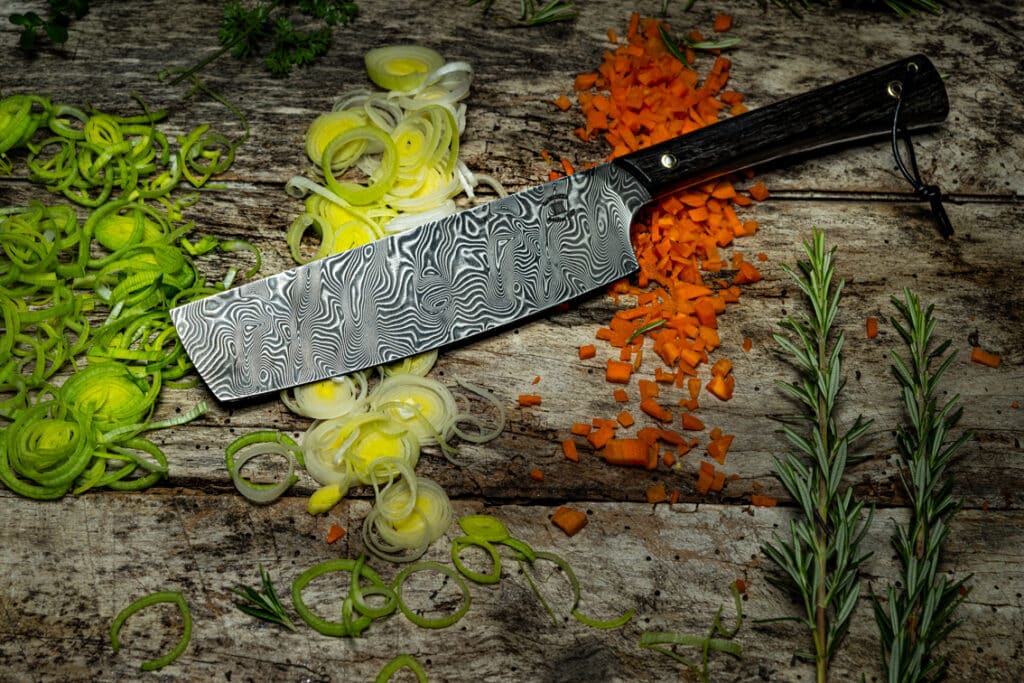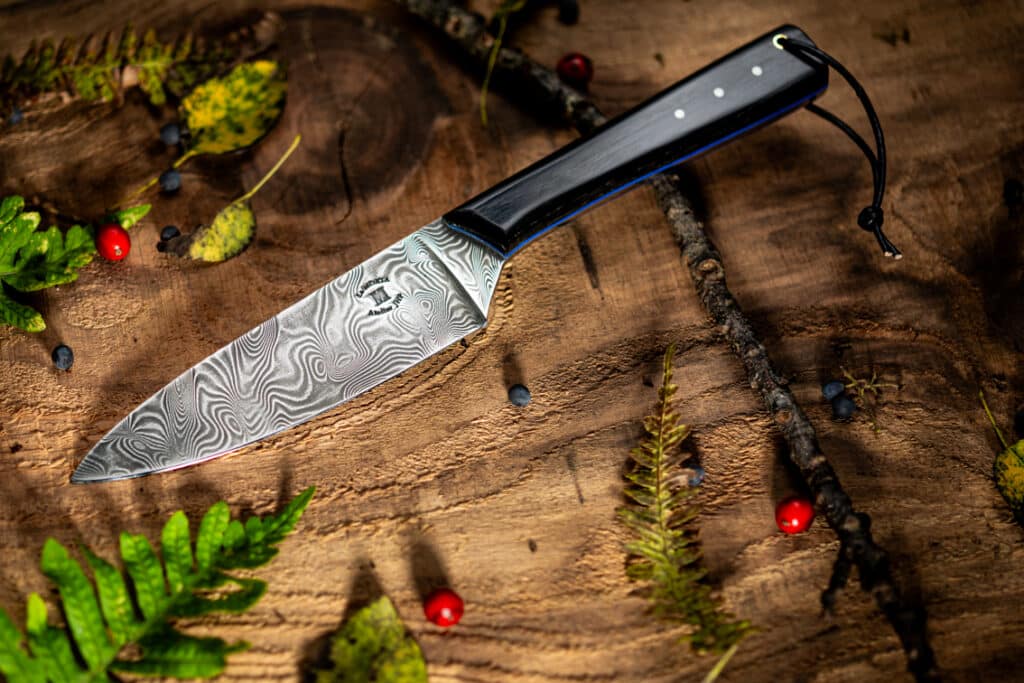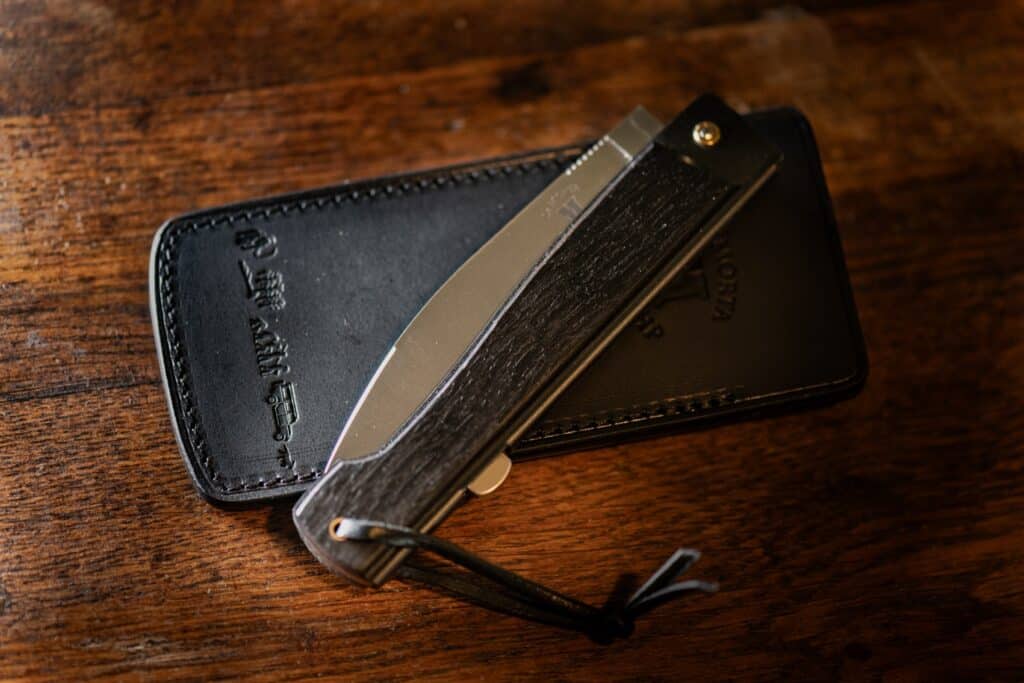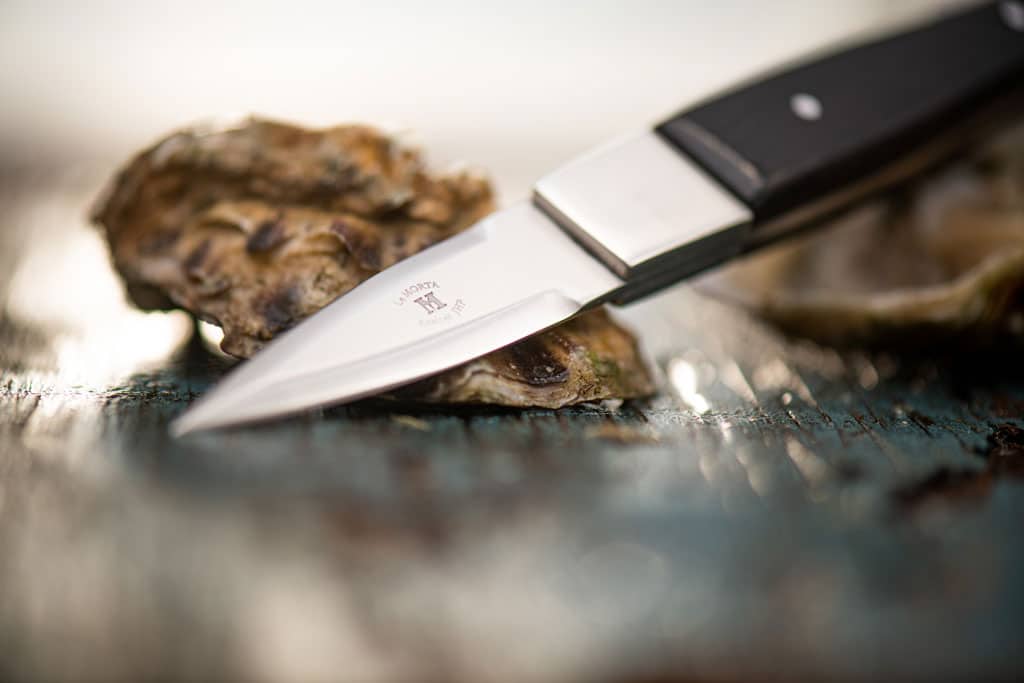The mere mention of “knife” conjures images of a butcher slicing through meat quarters or a grandmother peeling apples. In France, culinary art is akin to tradition. We take pride in setting beautiful tables with quality cutlery, tailored to the menu. In the kitchen, we appreciate using the right tools. However, even though one knife may closely resemble another, the reality is far more precise and technical. But what are the different types of knives? From table knives to paring knives and chef’s knives, each has its place in the kitchen. Morta Knives slices up a hefty portion of information, telling you all you need to know to pick the right knife.
Professional knives: A cut above the rest
Butcher’s meat knives
Butchers rough cut and size up meat quarters (beef, pork, lamb, or mutton) using cleavers, akin to small machetes. The blades, typically around 18 cm long, are broad to slice through large cuts often still connected by joints. Also known as the “butcher’s leaf,” when used flat, its wide and robust blade flattens the meat. A lighter version, the cleaver knife, is available for non-professionals.
Carving Knives feature longer (around 30 cm) and thinner blades. Depending on the task, professional butchers might use:
- A skinning knife (straight blade)
- A boning knife (often a thin blade curved upwards to separate meat from bone)
- A sticking knife (shorter blade, around 15 cm)
- A filleting knife (thin blade, sometimes curved upwards)
- A trimming knife* (long, flexible blade with a slanted edge)
- A slicing knife (long and tapered blade)
- A carving knife (typically a fine blade ranging from 18 to 30 cm in length)
*Trimming (for the uninitiated) means removing inedible or damaged parts (tendons, joints, ligaments, skin, nerves, fat, or rotten or sprouted parts of a vegetable or fruit).
Ham Knives falling under the meat knives category, they feature a flexible blade ranging from 25 to 35 cm.
Fishmonger’s knives
Fish, with its particularly delicate flesh, requires a specific blade for clean cuts, filleting, or descaling. Fishmongers typically use a wide, serrated blade for removing large bones, like vertebrae. The sole fillet knife respects the flesh’s integrity with its long, smooth, and precise blade. The salmon knife’s more flexible blade sometimes features hollows (perforated blade) to prevent the steel from sticking to the flesh.
The traditional oyster knife, self-explanatory in its name, is probably only taken out during the holiday season. Its short, triangular blade opens the shell without damaging the oyster. A towel is recommended to protect the user’s hand.
The sea urchin cutter comes either as a pair of scissors or as a small cleaver paired with a small board.
Cheesemonger’s knives
You’ve seen them on cheese shop counters. The most common cheese knife features two handles to distribute the effort evenly. Cutting a wheel of Parmesan or Tomme des Pyrénées, or any other hard-rinded cheese, requires some strength.
For soft cheeses, cheesemongers prefer a specific knife with a serrated, perforated blade. The forked tip allows for neatly picking up and serving slices.
This forked tip is also found on cheese knives for home use.
For crumbly, moist cheeses (like goat cheese or Reblochon), cheesemongers use a cheese lyre (similar to the one used for foie gras).
Lastly, if they wish to cut thin slices, the scraper is ideal for hard or semi-hard cheeses.
The different Japanese knives
In France, Japanese knives enjoy a reputation for quality.
In Asian restaurants, Japanese chefs employ various knives, such as Japanese tuna knives (long, curved blade) or sashimi knives for sushi preparation. Santoku and Yanagiba models (fine, asymmetric, and long blade) are used for precise fish cutting. Numerous other models are staples in Japanese kitchens.
- The Nakiri knife, with its large rectangular blade, is designed for cutting vegetables.
- The Kiritsuke knife resembles a cleaver.
- The Sujihiki knife slices meat or charcuterie.
- The Bunka knife is a versatile model.
- The Deba knife, with its asymmetrical and protruding blade, is used for forceful cuts.
- The Sushi knife delicately slices raw fish (who would have thought? 😉).
- The Gyutoh knife (thinner blade than a European chef’s knife) cuts vegetables, meats, and fish.
- The Shotoh knife (tapered blade of 9 to 14 cm) peels fruits and vegetables gently.
- The Pankiri knife, with its serrated blade, cuts bread without leaving crumbs.
Kitchen knives: Various types for different uses 🔪
Cooks, whether seasoned or budding, value having the right tools. “A worker is only as good as their tools,” you know the saying!
Also known as paring knives, kitchen knives vary based on need.
A high-quality stainless steel blade is preferred for better corrosion resistance. Regardless of the food being cut, a paring knife requires perfect hygiene (in restaurants, cafeterias, or at home) necessitating regular washes.
For each culinary task, there’s a blade to match.
Meat knives
The term ‘meat knife’ is generic. Its shape is dependent on the desired cut, significantly affecting the amount of juice produced during cooking.
Professional knives are increasingly making their way into home kitchens. A typical kitchen counter has trimming, filleting, and slicing knives.
The steak knife, however, is set at the table. It’s used to cut the meat on the plate before savoring it.
Vegetable knives
The vegetable knife (or peeling knife) is characterized by its ‘bird’s beak’ blade. Its curved shape allows for close cuts, especially for round fruits or vegetables like sweet potatoes or apples. Patisserie chefs value it for its ability to sculpt and refine finishes for optimal dessert and cake presentation (and not only). It’s often complemented by a vegetable peeler.
The wolf’s tooth knife, with its V-shaped, double-edged blade, is used for triangular cuts often made on fruits like melons or watermelons.
Cooks use long blades to chop and mince condiments (garlic, onions, aromatic herbs). They place one hand on the blade and the other on the handle for speed and safety.
Bread knife
France, the land of bread (and cheese…). The bread knife (with a serrated blade) stays in the kitchen. The head of the household slices the bread and places it in a basket on the table for the guests.
The versatile knife
True to its name, it does it all: deseeding, detopping, peeling… and it cuts, too 😉!
The paring knife: The ever-versatile
The paring knife is very common, a versatile jack-of-all-trades. Small, light, and easy to handle, it complements the traditional chef’s knife.
Peeling, slicing, mincing, detopping, peeling, it does it all. Multi-functional, it’s precisely the one you use every time you cook. Remember it for tailoring and trimming your ingredients.
Its toothless blade, measuring 7 to 11 cm, doubles as a table knife for daily meals.
The paring knife comes:
- With a straight blade for peeling fruits and vegetables, cutting into dices, mirepoix, or brunoises.
- With a slightly upward-curving blade for slicing or trimming your ingredients.
The chef’s knife
What exactly is a chef’s knife?
A chef’s knife is a multi-purpose kitchen knife, the kitchen essential.
Its thick blade is 4 to 5 cm wide and 16 to 36 cm long, typically around 20 cm. Versatile, it should be handy and practical for cutting common ingredients: meat, vegetables, fish. It’s used for chopping, mincing, slicing, and dicing.
How to choose a good chef’s knife?
The chef’s knife should offer perfect comfort and grip. The more comfortable you are with it, the faster and safer you will be.
Durability of your chef’s knife depends on the stainless steel quality of the blade. Like we’ve seen, it demands perfect hygiene.
At Morta Knives, the stainless steel is Sandvik 14c28n, offering a hardness of 59 HRC Rockwell for high quality, easy sharpening, and exceptional sharpness.
You’ll also find X50CRMOV15 stainless steel on boxed knives.
Damascus blades (steel folded to form laminated layers) offer a chic, randomly patterned visual.
The cutler’s skill also plays a role in the assembly and choice of material for the handle.
Table knives: Setting the standard
Moving away from the kitchen and heavy-duty cuts, what knives should you place on the dining table?
A properly set table is a mark of respect for your guests. The host delights in choosing a lovely tablecloth and quality cutlery.
Table knives are fixed (although some enthusiasts never part with their favorite folding knife).
Depending on the menu, you’ll find on the right side of your plate, the furthest being the first one to be used:
- A fish knife
- A steak knife
- A cheese knife
- A butter knife (for spreading)
- A dessert knife
The butter knife is often found on the cheese platter.
For casual meals, the bread knife is placed directly on the cutting board on the table.
I want beautiful quality table knives to delight my guests.
Pocket knives: The multi-activity model
A pocket knife: for what use?
Designed to easily slip into a pocket without causing injury, a pocket knife is always folding. It’s carried everywhere. Conversely, a folding knife isn’t just for outdoor use 😉. Various locking systems exist, hence the term ‘locking knife.’ You’ll find the slip joint, flat spring, Piémontais, rotating bolster, thumb stud, or the simplest, the friction folder.
It proves useful in daily life: fishing, hunting, country walks, combating sausage skins, or picking fruits or mushrooms.
It’s cherished for the incomparable emotion of eating with Your knife: a pleasure for aesthetes, private and particularly delectable.
Who uses a folding knife?
Besides adventurers and outdoor enthusiasts, cooks, DIY enthusiasts, gardeners, fishermen, walkers, shall we go on 😉?
Depending on its use, the pocket knife comes in models:
- Handcrafted for a beautiful Made in France piece
- Luxury, akin to jewelry
- Engraved for unique personalization
- Damascus for fans of this exceptional steel
Safety system knives: Secure your slice
All pump knives rely on the same mechanism: a spring. However, they are not all identical. On the back-lock (or lock-back), the lock is at the rear, opposite the front-lock. The locking rod releases with pressure on the pump.
The liner lock keeps the blade open with a cut-out plate. Opening and closing can be done with one hand.
Discover the back-lock knife from Morta Knives.
🔪 The ferrule is a traditional French model. It’s a steel ring, consisting of a fixed part and a sliding part, located between the blade and the handle. Locking and unlocking are done by rotating the ferrule.
🔪 The Piémontais, sometimes called Vernantin, is a very old locking system. It’s recognized by the heel of the blade and its lens. With a thumb press, this little loupe allows the blade to appear. Locking is done by pressing on the handle.
🔪 The Capuchin owes its name to the shape of its handle, resembling a… hood!
🔪 The slip joint (or slip-joint) has a spring on the upper part of the handle. Pressing on the back of the handle closes the knife. It’s not a locking system per se since strong pressure disengages the blade and the handle.
🔪 The flat spring has a notch on the end of the spring, similar to the slip joint despite some technical differences. Mechanically very simple, it doesn’t have a lock, making it less secure.
🔪 The friction folder (with two pins) stays open (or closed) due to the blade’s friction against the handle. One pin keeps the blade aligned, the other acts as a stop at the heel.
🔪 The ratchet knife has an upper leaflet that you simply lift to open the knife).
🔪 The palm knife (or leaflet or ring knife) has a flat spring into which the blade’s heel hooks. The blade unlocks when lifting the palm using the ring. It was a common model in Spain, Italy, or Sardinia.
Universal and timeless knife
This everyday and timeless knife sometimes becomes a collector’s item. Symbolizing tradition and heritage, it’s often passed down from generation to generation. It carries an emotional as much as practical value, transcending its technical aspects. It becomes a mark of personality, which is why it’s often gifted engraved.
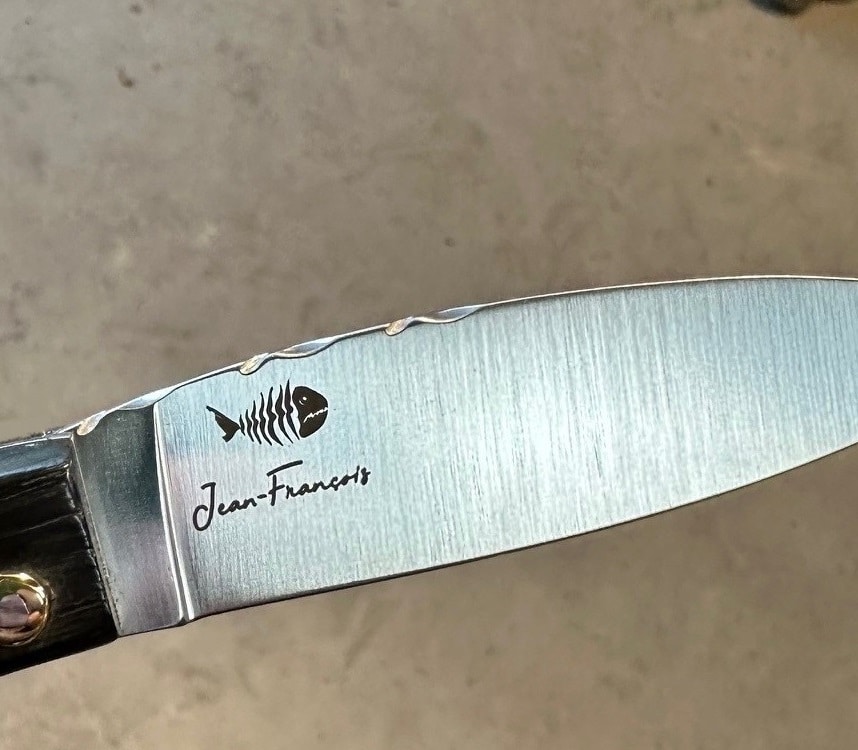
At Morta Knives, you can personalize your folding knife with the name of the (future) owner and/or a pictogram designed by the Baulois artist Nicolas Peyron.
If you too appreciate local products, Made in France will speak to you more than an industrial model with a G10 handle.
The material of the handle greatly influences the aesthetics and quality of the knife. Wood, horn, or even better: a Morta handle, which will you choose?
At Morta Knives, you can choose to enhance it with mammoth ivory or a blue vulcanized fiber trim.
It’s generally presented with its case, either a sheath or a storage pouch.
Conclusion: How to choose the best knife?
As you’ve understood, a knife is chosen primarily based on its use, its function. Its grip should be perfect for greater dexterity, comfort, and safety. Culinary enthusiasts diversify their models based on their work habits: meat, fish, vegetables. Each cut calls for a specific blade shape. If you’re only occasionally in the kitchen, prefer traditional, versatile office models. If you’re more nomadic than homebound, opt for the folding version.
So, have you made your choice?
🪶Article penned by the sharp quill of Christelle Lorant.
6 frequently asked questions
What are the different types of kitchen knives and their specific uses?
Chefs employ a variety of kitchen knives, each tailored for particular tasks. Butcher knives are perfect for cutting meats, while the vegetable knife, with its curved blade, excels at sculpting and peeling fruits and vegetables. For precise cutting of meat or fish, the Santoku knife is a popular choice due to its versatile blade.
Why is it important to have different types of knives in a kitchen?
Having a range of knives is crucial for efficient and precise food preparation. Each knife is designed for specific tasks, such as chopping herbs, slicing large cuts of meat, or peeling fruits and vegetables. Using the right type of knife for each task not only ensures precise cuts but also enhances safety in the kitchen.
How do you choose the most suitable knife for your kitchen needs?
Selecting the right knife depends on your cooking habits and the types of food you most often prepare. For versatile use, a chef’s knife or Santoku knife is recommended. For specific tasks like peeling fruits or chopping herbs, consider a vegetable knife or a paring knife. Take into account the blade quality, grip, and blade type to make a choice that meets all your culinary needs.
What are the benefits of a chef's knife in daily meal preparation?
The chef’s knife is one of the most versatile and essential knives in a kitchen. Its broad and sharp blade is perfect for chopping vegetables, mincing herbs, and slicing large cuts of meat. Its versatility makes it suitable for almost all cutting tasks, making it an excellent investment for anyone looking to enhance their kitchen efficiency.
What is the difference between a Santoku knife and a chef's knife?
While both the Santoku and chef’s knives are versatile, they have notable differences. The Santoku knife, of Japanese origin, has a wider blade and a rounded tip, ideal for the sweeping cutting technique. The chef’s knife, on the other hand, has a sharper tip and a slightly more curved blade, perfect for the rocking chopping technique. The choice between the two depends on your personal preferences and cutting style.
How do you maintain and preserve your knife's blade to ensure its longevity?
To maintain your knife’s quality, it’s important to hand wash it with warm water and a bit of detergent, then dry it immediately. Use a proper cutting board to avoid blunting the blade. Regularly sharpen the blade with a whetstone or honing rod to maintain its optimal sharpness. Finally, store the knife in a knife block or on a magnetic knife holder to protect its blade.


